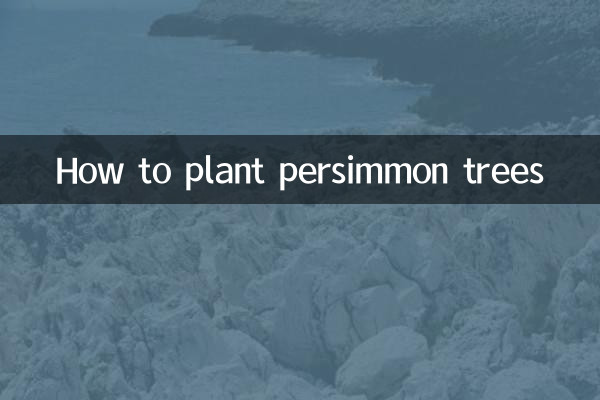How to plant persimmon trees
The persimmon tree is a common fruit tree that not only has sweet and delicious fruits, but also has a beautiful shape, making it suitable for planting in courtyards or orchards. In recent years, with people's pursuit of healthy life, more and more people have begun to pay attention to persimmon planting methods. This article will introduce in detail the steps, precautions and FAQs for planting persimmon trees to help you successfully plant persimmon trees.
1. Basic information about persimmon trees

The persimmon tree (scientific name: Diospyros kaki) belongs to the genus Diospyros kaki of the family Diospyrosaceae. It is native to China and later spread to Japan, South Korea and other places. The fruit of the persimmon tree is rich in vitamins A, C and dietary fiber, and has high nutritional value. Persimmon trees have a long life span, which can last for decades or even hundreds of years.
| property | Details |
|---|---|
| scientific name | Diospyros kaki |
| Family | Persimmonaceae |
| country of origin | China |
| fruit ripening period | September-November |
| Suitable climate | Temperate to subtropical |
2. How to plant persimmon trees
1.Select variety: There are many varieties of persimmon trees, such as sweet persimmon, astringent persimmon, etc. Choose appropriate varieties based on local climate and market demand.
2.Site selection and soil preparation: Persimmon trees prefer a sunny, well-drained environment. The soil is preferably loose and fertile sandy loam, with a pH value between 6.0-7.5.
| step | Operational points |
|---|---|
| Site selection | Sufficient sunshine, sheltered from wind |
| soil improvement | Add organic fertilizer or humus soil |
| dig a hole | Depth 50-60cm, width 60-80cm |
3.planting time: Spring (March-April) or autumn (September-October) is the best time to plant persimmon trees.
4.Planting method: Place the saplings into the dug holes, fill them with soil, compact them, and water them thoroughly. After planting, keep the soil moist but avoid waterlogging.
3. Daily management of persimmon trees
1.watering: Persimmon trees are drought-tolerant, but the soil needs to be kept moist during the seedling stage. Mature trees are watered once a week during the dry season.
2.fertilize: Apply organic fertilizer once every spring and autumn, and add phosphorus and potassium fertilizer during the fruit expansion period.
| period | Fertilizer type |
|---|---|
| spring | Organic fertilizer or compound fertilizer |
| autumn | organic fertilizer |
| Fruit expansion stage | Phosphorus and potassium fertilizer |
3.prune: Prune leggy branches, diseased and weak branches in winter to promote fruiting next year.
4.Pest and disease control: Common diseases include anthracnose and scab, and insect pests include persimmons, aphids, etc. Biological pesticides or chemical agents can be used for control.
4. Frequently Asked Questions
1.What to do if the persimmon tree doesn’t bear fruit?: It may be due to insufficient tree age, poor pollination or insufficient nutrition. It is recommended to check the variety characteristics and supplement fertilizers.
2.What causes persimmon fruits to crack?: Usually caused by uneven water supply or calcium deficiency. Pay attention to balanced watering and calcium supplementation.
3.What should I do if the persimmon tree leaves turn yellow?: It may be iron deficiency or the soil is too wet. Iron fertilizer can be sprayed or drainage improved.
5. Summary
Planting persimmon trees is not complicated. As long as you master key aspects such as site selection, planting, management, and pest control, you can harvest abundant fruits. Whether it is garden planting or large-scale cultivation, the persimmon tree is a fruit tree worth recommending. I hope this article provides you with practical planting guidance.

check the details

check the details